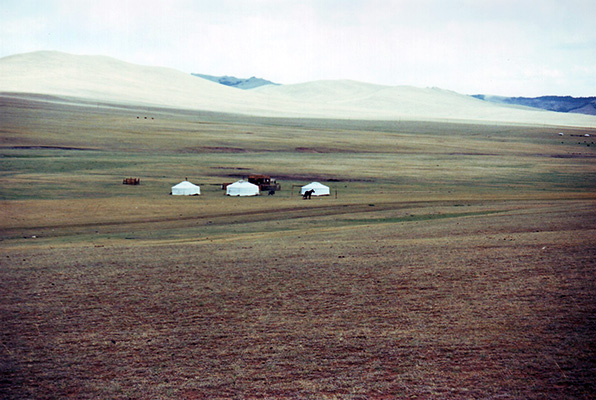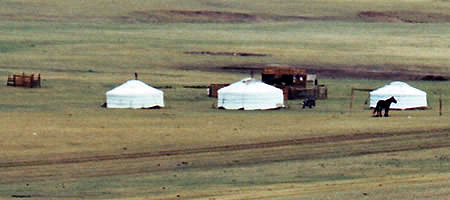Coexistence in Mongolia
Article and photos by Claire Morris

|
|
Mongolian gers in the distance.
|
They say that once nomads roamed the earth, coexisting with the land. This is an appealing concept: no stone walls or timber fences demarcating territory, only vast, shared spaces extending to the horizon and beyond. Yet it seems unrealistic in a controlled-air office in a sprawling North American city — or did before I visited Mongolia.
This Central Asian country is one of the few places in the world where the nomadic way of life continues. Herders follow time-honored transhumance patterns, living as part of a loosely knit community yet dependent on their animals and the land.
I’d read that Mongolia celebrates the world’s lowest population density. Once we’d left Ulaanbaatar behind, it was easy to understand how the nomadic life might still be practicable. The steppe rolls away: empty, unowned, gloriously undisturbed. Goats and horses were meant to roam here, and the people who tend them, too. Nearly half the population of Mongolia lives as herders these days. Out in the steppe, you catch glimpses of them on horseback, moving their flocks onto untouched pasture. Their gers nestle into the landscape, round felt tents that leave only a slightly off-color patch of tussocky grass as evidence of their stay once they’ve moved on.
“Today I show you Mongolian life,” Ganaa, our translator, announces as we breakfast on rice porridge at our camp. My two companions nod enthusiastically, and I have visions of some calls from Ganaa’s cell phone that, yes, do pull down a signal in this part of the steppe. But the only preparations we make before leaving camp are to ensure that our water bottles are topped up and that we carry some of the fruit and cookies we picked up in an Ulaanbaatar supermarket before hopping in the all-terrain vehicle to come out here to spend a few nights in a ger.
Surrounding our small camp is emptiness, but Ganaa sets off confidently on foot in a direction that could have been north, south, east, or west. It’s impossible to tell on this windy, cloud-strewn day. The three of us follow her, aiming for a pack of horses grazing below the horizon. Hot desert air shifts our shirt sleeves and tied-back hair, making me thankful we’re 4,200 feet above sea level. It’s exhilarating out here, walking with no apparent goal in mind, winding our way through the small, muscular Mongolian horses, descendants of those Ghengis Khan’s horde galloped west to intrude on the peace of many a thirteenth-century people group. The animals regard us warily but do not shy away when they see we haven’t come to move them elsewhere.
Once we reach the horses, three white objects are visible ahead — a cluster of gers, a family encampment. As we near, I notice one magnificent stallion, clearly prized, tethered to a post on the incline backing the gers. Between two of the tents rests a motorcycle.

|
|
Mongolian gers.
|
The camp appears deserted, but Ganaa strolls up to the door of the first ger and calls out, “Nokhoi khorio.”
No response, save the prize horse tossing its head.
Ganaa rounds the second ger and again calls, “Nokhoi khorio.”
Moments later, a stiff-moving woman emerges from the doorway. It’s impossible to determine her age. She looks seventy but could be much younger. She wears a T-shirt and Western-style pants. At the sight of us clustered uncertainly together, her face creases into a smile — tinged with surprise and warmth.
“Sain baina uu,” she says. “How are you?”
In Mongolia, a traveler can ride all day without encountering a single sign of life. This reality has led to immutable laws of hospitality. Turn a stranger away from your ger, and they might perish. And so, it is not done. The fact that we happen to be neighbors for now camped an hour’s walk over the horizon makes no difference either. We’re here and must be asked inside to take refreshments.
Our hostess ushers us into the ger, and we file round to the left, at her prompting, settling on the box beds opposite the door. A younger woman squats by the wood stove; she smiles and nods a welcome. She reaches gracefully for a kettle, checks its water level, then places it on the stove to heat.
When salty tea in bowls has been distributed all around, the younger woman vanishes out the door, and her mother-in-law takes up a basin filled with curds. Following the requisite clockwise route, she ladles these out into our palms. We accept with the right hand outstretched and the left hand steadying the right wrist, as Ganaa has taught us. The mixture feels cool and messy against my skin, but when I slurp it up, it tastes delicious — fatty, creamy, crunchy. It’s my first encounter with sheep’s curds, and I later accept a second ladleful.
The Mongolian herds people live primarily on meat and, in the summer, milk, yogurt, cream, and cheese, but our hostess graciously accepts the oranges and packaged cookies we present her with in thanks for her hospitality. Ganaa later explains that while Mongolia’s nomads continue to practice the old ways, using each part of the animal — including skulls to flavor stews and ankle bones for game pieces — they are twenty-first-century nomads, and so will supplement their traditional diet with items like these when the opportunity arises.
Like the food the people consume, their ger’s furnishings are a fascinating amalgam of traditional and present-day. The box beds we perch on are painted orange, with blue, green, and white patterns, as are the low table and accompanying stools, the ger’s door, and the chest that houses the family’s cooking utensils. The tent, heavy felt made from sheep’s wool, is anchored by several posts and a wooden frame, with extra support from ropes that can be weighted down with rocks during storms or high winds. When the weather’s more peaceful — like now — the ropes are twined beneath the rafters in a definite pattern; twisting them the alternate way can bring misfortune on the ger’s occupants. A utility clock — seen in millions of North American kitchens — adorns the ger wall, while a baseball cap and a bottle of water rest on the side of the bed where our hostess sits.
She presides over the small gathering like she has welcomed strangers into her home thousands of times before, and no doubt she has. She asks Ganaa where we are from and nods approvingly at the words Canada and England. We, in turn, ask about her family, her life, and the health of their livestock.
“She has six sons,” Ganaa translates. “They are today out with the flocks, but will be home before dark for their evening meal.”
It turns out everyone is healthy and thriving. “There are thirty horses and one hundred and twenty sheep and goats,” Ganaa tells us. “Many babies born this year too.”
I ask about the horse tethered outside. Ganaa and our hostess speak at length before she explains that this one is being reserved for Naadam, the yearly national festival held in July, where horse racing is only one of the sports.
We ask how long they have camped in this spot.
Again Ganaa consults with our hostess. “They will be here until autumn,” she says.
We learn that this family moves their camp twice a year. They spend the summer in isolation on the steppe and the winter in a village closer to Ulaanbaatar with a group of other families.
“And do they return to the same location each spring?”
Ganaa shakes her head. “Only if the grazing is sure to be good.”
One look at the steppe grass and it’s hard to imagine how animals can thrive here. Yet, they have adapted to Mongolia’s vegetation. There might be no proverbial fatted calves, but the sheep and goats raised on this terrain keep their people well-fed and well-clothed.
Many Mongolians returned to the nomadic way of life after the dissolution of the Soviet Union. Independence and democracy challenged families attempting to make ends meet, and the steppe proved a savior. While the average nomadic family lives officially below the poverty line, they have their ger, mutton, horses, wool, and milk products. This centuries-old lifestyle might be threatened by twenty-first-century demands, calls for privatization, and economic gain versus subsistence living, but it seems unlikely to disappear unless it is mandated.
We take our leave after an hour, acting on one of the lessons we learned upon arriving in Mongolia: balance time spent socializing with respect for the work your host must do. With profuse expressions of thanks (bayarlalaa, bayarlalaa), we retrace our route across the steppe until the three gers are no longer visible on the horizon behind us.
We do not see our hostess again, but three of her sons come to join us at the campfire that night. Laughing and chatting with the Mongolian men and women who work at our camp, they sing ballads of horsemanship and true love. And seem happy.
The crackle of the flames and the haunting tunes are the only sounds drifting out into the Mongolian night. I gaze up at stars whose light is unimpeded by city neon and reflect on our visit to our nomadic neighbor. Could I be as hardy as resourceful to survive without a supermarket, running water, electricity, or plumbing?
“These songs, they are very old,” Ganaa whispers to me. “Traditional music. Our Mongolian heritage.”
A heritage that includes remaining fiercely conscious of culture even through occupation, continuing to follow laws of migration and generosity, galloping across the steppe as the goats and sheep part to make way, and offering hospitality to me, an outsider, with no expectation of anything in return. They might use cell phones, motorbikes, Western-style clothing, and packaged rice and flour, but they cherish the art of coexisting with their land, their animals, and each other.
Back in my North American office, where cubicle walls define territory, I think about them often.
Claire Morris is a writer, editor and travel junkie.
|
